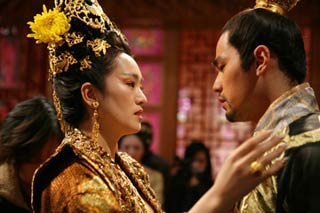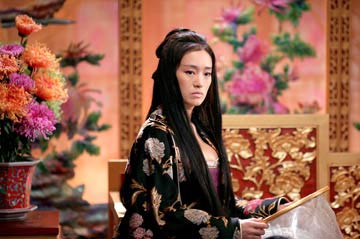Human Flower Project
Sunday, January 28, 2007
Curse of the Golden Flower
Zhang Yimou’s movie of “Extraordinary People” surrounds a sea of venom with acres of flowers.

The Empress conspires with Prince Jai
on the eve of the Chrysanthemum festival
Photo: Bai Xiaoyan
When a loyal son chooses to defy his father—a treacherous medieval emperor with hair down to there— what happens?
Here’s what: A zillion warriors dressed in gold mail and helmets meet a kazillion soldiers in silverplate, and they clash before the palace, fighting it out on a sward of yellow chrysanthemums the size of Tennessee.
Zhang Yimou’s Curse of the Golden Flower, the most popular film in Chinese history, took $42 million to make. Cheap, we say, considering the flower budget alone. There is a gorgeous painting of peonies in the apartment of Number One Son, Prince Wan. The hallways are paneled with faux-ivory screens “carved” into floral motifs. Ladies in waiting sprinkle petals into the prince’s bathwater. Floral carpets roll down a flight of two hundred stairs. The Empress, played with a pout of grandeur by Gong Li, wears golden flowers in her upswept hair and painted flowers on her long nervous fingernails. Her chambers are filled with vases of gerberas and big pots of chrysanthemums—purple, white and yellow. And throughout the film, she embroiders golden chrysanthemums stretched over a hoop of silk, in preparation for the Chong Yang Festival, the climax of the story.
Many Western critics, accustomed to such fare as “Sex, Lies & Videotape,” mock the opulence of Zhang Yimou’s film. (Some Chinese directors have called the film garish, too). How misguided and cranky. The big screen was built for scale and ornamentation like this. The color! Hundreds of attendants dressed in royal blue carry pots of yellow mums down from the terrace. Against a background of red and gold, the palace pillars are wrapped in velvety, psychedelic pink, green, and orange. This is no Podcast but maximalist film making. Can you handle it?

The Empress (Gong Li) ascends to the Chrysanthemum Terrace
in Curse of the Golden Flower
Image: via parakiss
Chrysanthemum is the “golden flower” of the saga. Blooming in autumn as others fade, it symbolizes robustness and nobility. In Chinese popular tradition, its virtues are celebrated on the ninth day of the ninth lunar month, the holiday known as Chong Yang.
“In the tradition of yin and yang, these nines are doubly yang, which connotes positive energy and masculinity. Chong Yang is celebrated by feasting with the family, honoring ancestors and the elderly, and often by hiking to a mountaintop or ascending to a high place—such as the Chrysanthemum Terrace in Curse of the Golden Flower—to appreciate nature and to escape from evil spirits.”
This piece from People’s Daily helps illuminate the complex meaning of chrysanthemum in China and the working of symbol itself. Our Western expectation had been that in the royal family conflict, one side would emerge as the true “chrysanthemum ” and carry the day. But the movie is more interesting than that. It’s a battle over power (“positive energy and masculinity”) embodied in the autumn flower. And as such, “escape from evil spirits” is hard to come by.
Though the film’s characters are fictional, the story takes place in the last years of the Tang dynasty. Not coincidentally, “Another famous figure identified with the chrysanthemum is Huang Chao who lived in the 9th century. Huang was the leader of a peasant revolt towards the end of the Tang Dynasty (618-907). He led an army of thousands and occupied Luoyang after several years of fighting.
“He wrote two poems about the chrysanthemum, one of which contains the lines: ‘If I could be the king of the flowers, I would allow the chrysanthemum to bloom with the peach blossom; The fragrance (of the chrysanthemum) would fill Chang’an City, and the city would be clothed in golden armour.’”
 The Empress embroiders chrysanthemums by the thousands, but why?
The Empress embroiders chrysanthemums by the thousands, but why?
Image: Yahoo Movies/Gong Li
This, we learn, was a chaotic time in Chinese history, as the Tang empire splintered and Chinese warlords vied for control. According to this fine review, “The Emperor can be seen as one of the military men who seizes power…The Emperor’s rigid insistence on following ritual and ceremony can be seen as a mark of his hypocrisy; he aspires to the glory days of the Tang Dynasty, but he is really a latter-day usurper.”
We hope not to have given too much away, The plot’s thick, the violence is knifey, the costumes are nominated for an Academy Award, and the flowers are plush. We recommend a movie break from English schools and Brad Pitt with three days’ beard. As the Empress says to Prince Jai on the eve of the great festival: “The chrysanthemums are ready. They deserve to bloom once.”




